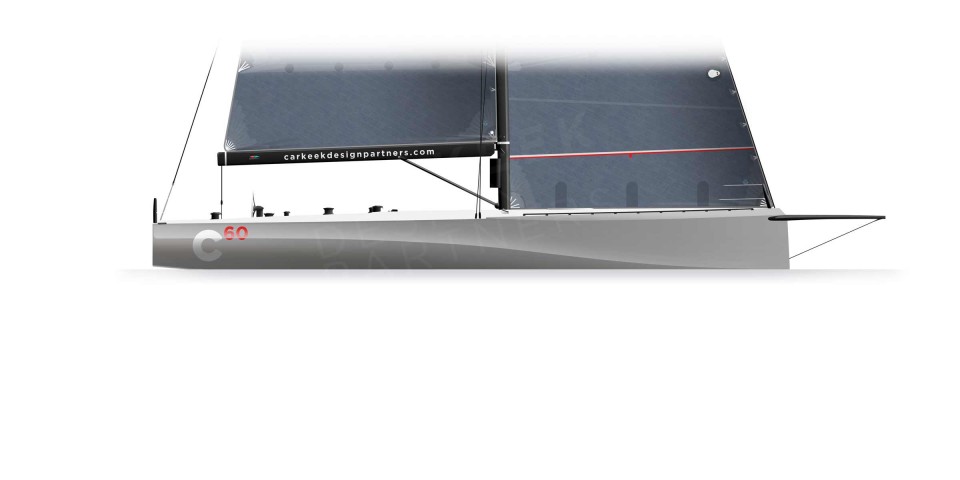C60
The C60 HP-IRC yacht is optimized for all-round sailing and is a strong offshore contender, moded for the 2013 Sydney Hobart race.
The Carkeek 60 is a boat primarily designed for long offshore races. The first being Matt Allen’s ‘Ichi-ban’, set up specifically for the 2013 Sydney to Hobart race. 60ft was chosen after discussing the race with Matt, and assessing the broad range of expected sea states and the average conditions.
Matt is also interested in racing around the buoys, and so the C60 is really a boat which benefits from our recent developments in HP-IRC racing yachts and our in-house tools used to design them. The differences between IRC and HPR reduce as LOA increases, so optimising for both these rules was a simpler task, compared to the smaller C40’s and C47.

The rig design is ultra high modulus Southern Spars. We worked closely with North and Southern on the rig and sail optimization to ensure synergy between the various elements. Utilizing the same software helped achieve optimized results within a short time period.
Considerable energy was spent optimizing the sail plan in terms of mast positions and rig dimensions, area distribution and naturally the sale shapes themselves.
The yacht was designed around the powered winch systems and set up towards to the lighter end of the rule to ensure low transitional speeds downwind. The yacht featured a large sail plan for outstanding light air capabilities yet combined with a high stability powerful hull form enables the yacht to come into its own upwind in the breeze. Very much and all-round high performing design where go fast features have been optimized against the rule rather than go slow features.
The high aspect deep draft keel support the tall rig and is optimized to ensure strong upwind performance around the buoys on ww/lw courses.
We’ve considered dual sailing although Hull 1 will race predominately in IRC hence our focus on the rule. We slanted the Boat 1 mode to Australian conditions especially offshore Sydney Hobart and Coastal racing.
With its very high SA/Disp ratios we looked at a number of fin design options and appendage set-ups to balance the boat and ensure a strong high mode for windward/leeward racing.
One of our first decisions was to keep all the sail handling systems onboard hydraulically operated, and almost all below deck. We spent considerable time analysing this decision, from both a weight (larger engine, fuel weight, hydraulic lines and systems) and a rating penalty perspective. Despite these, we believe there are clear advantages which a full hydro set-up affords. The primary advantage is being able to trim the sails properly throughout the race without relying on crew to grind all night, resulting in maximum performance at all times. In addition, the lack of manual grinders allow the crew to position themselves strategically both up and down wind in a manner that is both efficient for them as well as for driving the boat to optimum speeds. A further benefit is that the cockpit is open, clear and uncluttered, helping crew movement during maneuvers.

Further forward is a large jib tack recess, below which the hydraulic cylinders for the headstay and jib tack are supported independent of the rig set-up. This allowed us to simultaneously fine tune the rig and detail the structure and deck design independently until the optimum J dimension was known. An added benefit is that no added deck compression occurs as rake is changed. The large bowsprit (well over 2m long) with its titanium snout includes typical offshore features such as martin breakers, but also a low profile titanium tack pullback bar to assist in peels when using the large furling kites.
Related projects

C100 Racer
The Carkeek 100 is a record breaker, designed to win under IRC either offshore over long distances or inshore around the buoys.

TP52 2015
This striking design introduces our latest ideas, concepts, technology advances and race success from the HPR grand prix arena into this

C72
Our C72 mini maxi is state-of-the art incorporting many innovative features following extensive research over the past 6 months. We are looking

C60
The C60 HP-IRC yacht is optimized for all-round sailing and is a strong offshore contender, moded for the 2013 Sydney Hobart race.

C54
The C54 HP-IRC is perfect owners requiring a more all-round platform to a TP 52, especially in coastal and offshore scenarios. More info soon.

C47
The C47 is a powerful grand prix racer optimized to the HPR-IRC racing rules. Created with similar performance charachterstics of the C40 MKi and Mkii.

C440
The C440 is one of our latest designs aimed at mid range size HP-IRC bracket. More info coming soon.



